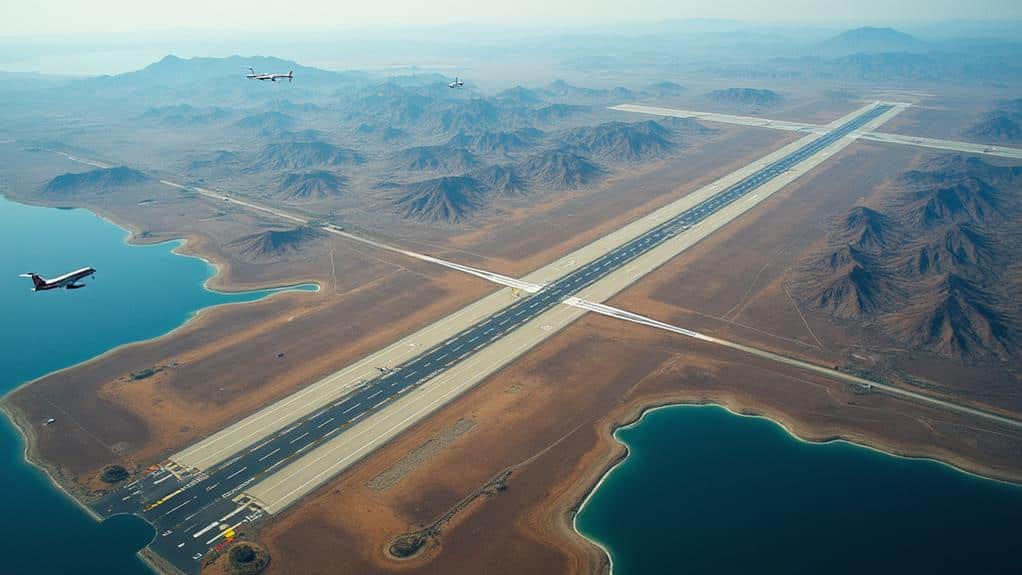Yes, you can fly your plane to another country, but it’s a complex process requiring extensive preparation. You’ll need to obtain overflight and landing permits, file detailed flight plans, and comply with customs regulations.
Each country has unique aviation rules, so thorough research is vital. You must coordinate with destination airports, arrange landing fees, and follow specific customs and immigration procedures.
Proper documentation, including passports and visas, is mandatory. Regional variations in regulations add further complexity, especially in areas like the Schengen Zone, China, and the Middle East. Understanding these requirements is essential for a smooth international flight experience.
Quick Tips
- You can fly your plane to another country, but extensive preparation and legal compliance are required.
- Obtain necessary overflight and landing permits from relevant aviation authorities before departure.
- File a detailed flight plan and submit passenger information through systems like eAPIS for international flights.
- Ensure compliance with customs regulations, including valid passports, visas, and customs declarations for all passengers.
- Research and adhere to destination-specific legal requirements, varying significantly between countries and regions.
Legal Requirements for International Flights

Finding your way through the legal maze of international flights can be challenging for private pilots.
You’ll need to obtain overflight and landing permits from aviation authorities, which can take days to process. Additionally, understanding airline policies on transporting personal items, such as umbrellas, may help guarantee a smooth trip once you arrive at your destination, especially since some places have unique rules about airline rules for umbrellas.
Compliance with customs regulations requires passports, visas, and customs declarations. Each country has its legal requirements, so research destination-specific regulations carefully. You’ll also need to file a flight plan and notify customs for many international flights.
Filing Flight Plans Abroad
When venturing into international airspace, filing a flight plan is a critical step you can’t afford to overlook. You must submit detailed information about your route, departure, and arrival times, and aircraft for international private aircraft. Additionally, guarantee compliance with local regulations, which can vary greatly between countries, much like airline rules for personal items.
Don’t forget that eAPIS filing for U.S. flights requires passenger data submission 60 minutes before departure. Each country has unique aviation regulations, so research your destination’s requirements to avoid penalties when traveling internationally.
Airport Coordination Essentials

Steering through the complexities of international airport coordination is vital for a smooth flying experience. You’ll need to maneuver landing permissions, customs and immigration procedures, and pre-arrange landing fees. Additionally, it’s important to be aware of TSA regulations for medications that may impact your travel plans.
Compliance with local regulations is essential, as each country has unique requirements. Plan carefully and communicate directly with your destination airport to guarantee that you meet all necessary conditions for international travel. Failing to coordinate properly may result in landing denials.
Customs and Immigration Procedures
After maneuvering the intricacies of airport coordination, you’ll face the next challenge: customs and immigration procedures. When flying your international private jet, you’ll need to clear customs upon arrival. Guarantee all passengers have valid passports and file an eAPIS before departure.
At your destination, present your customs declaration and required documentation. While customs procedures for private pilots are often quicker, be prepared for additional inspections in some countries.
Regional Variations in Regulations

Five key regions present distinct regulatory challenges for international private pilots. The Schengen Area has specific customs and immigration processes, while China requires military clearance for airspace access.
Eastern Europe and the Middle East often impose stricter documentation requirements than Western countries. Local aviation authorities guide regulations for international flights, which can vary considerably between regions. You’ll need to research permits and procedures for regional airports before travel.
And Finally
Flying your plane internationally is possible, but it’s a complex process. You must meet strict legal requirements, file detailed flight plans, coordinate with airports, and maneuver through customs and immigration procedures. Remember, regulations can vary greatly between regions. It’s essential to research and prepare thoroughly for each aspect of your trip.
While challenging, proper planning and adherence to all rules will allow you to enjoy the unique experience of piloting your aircraft across international borders.



